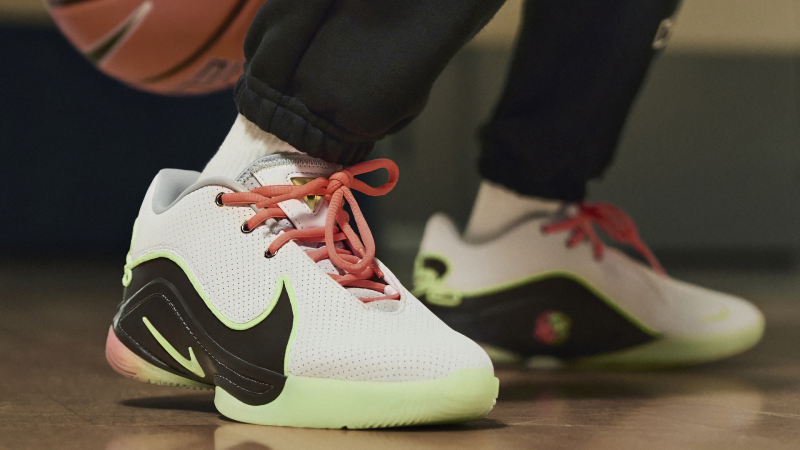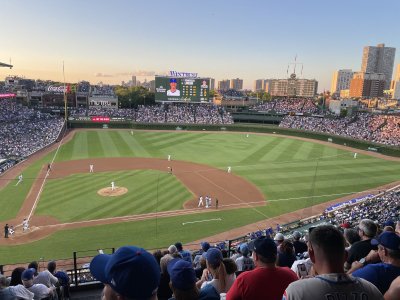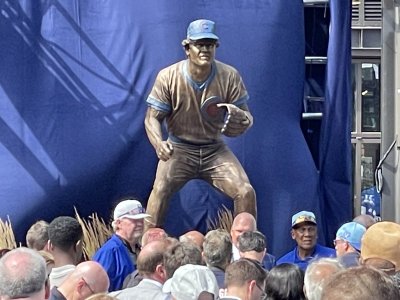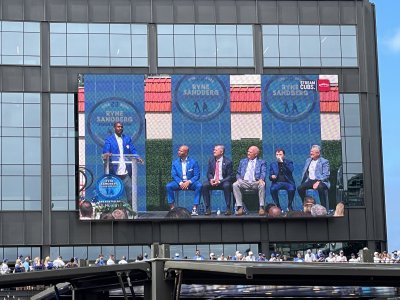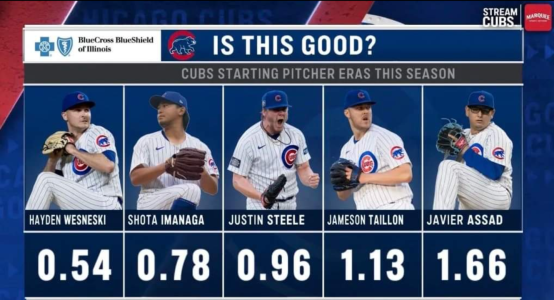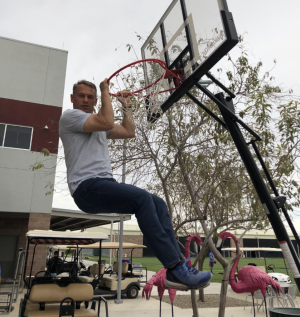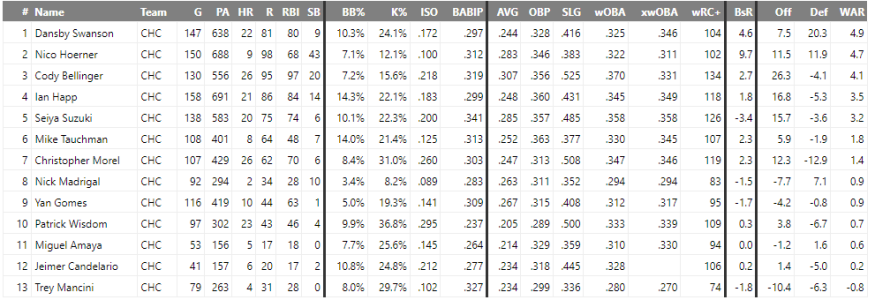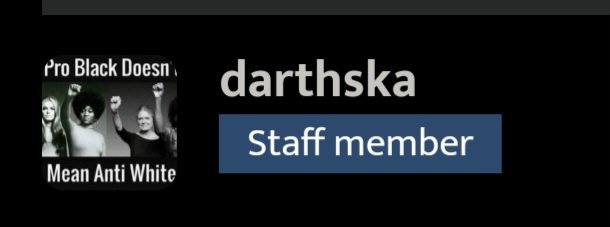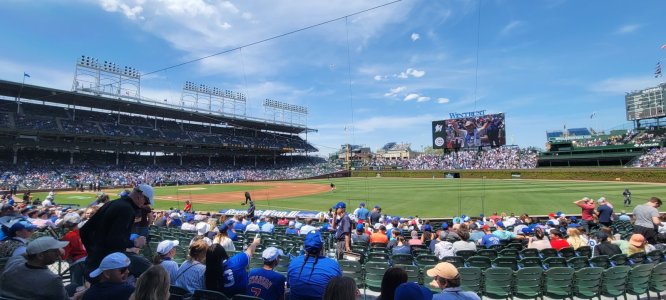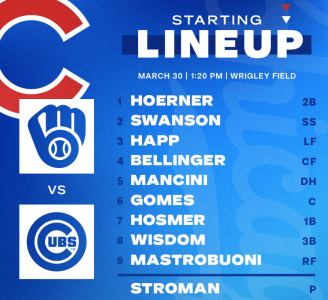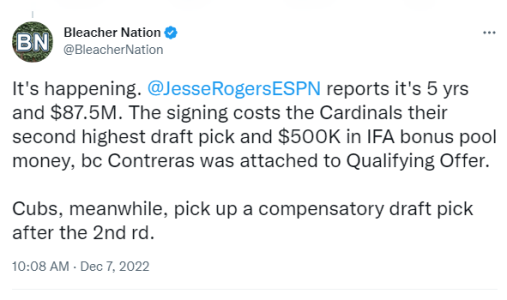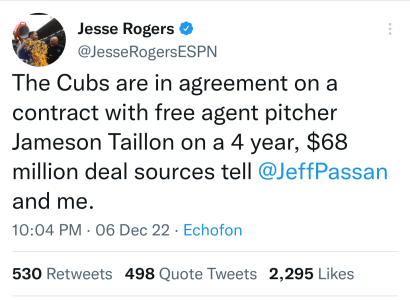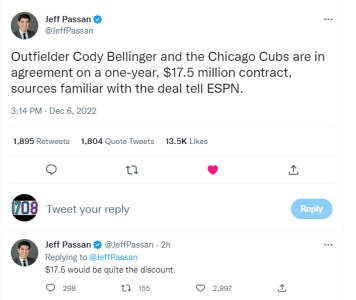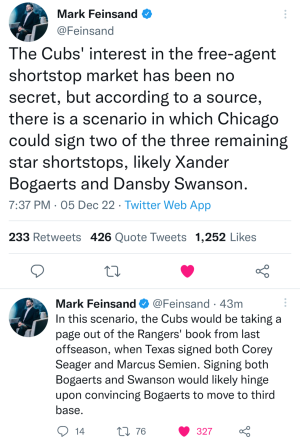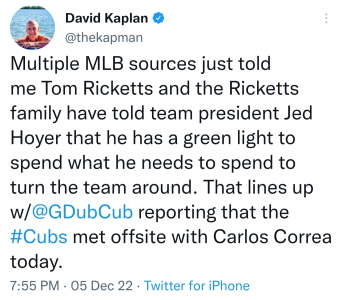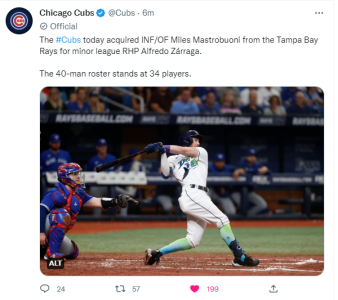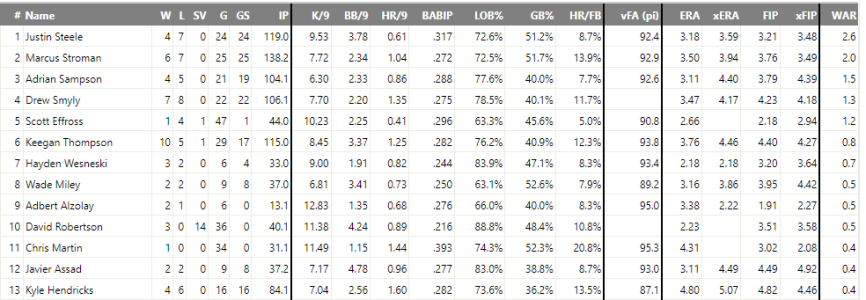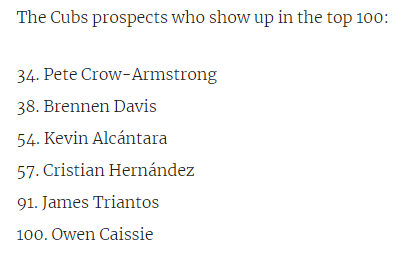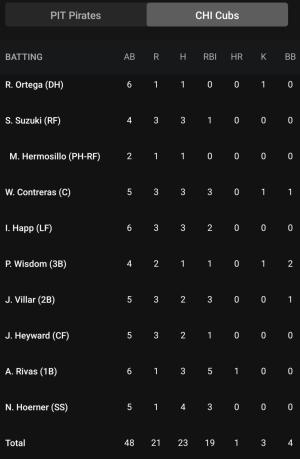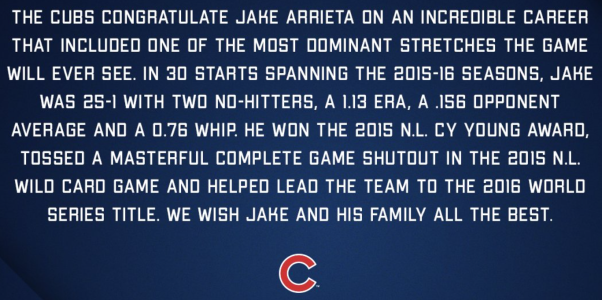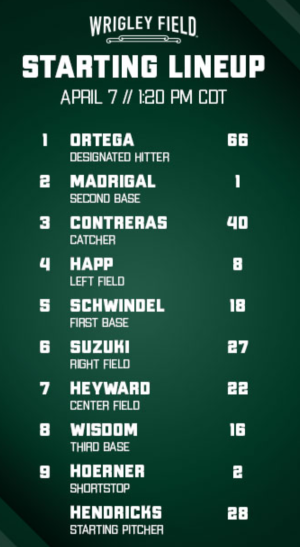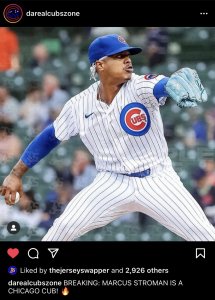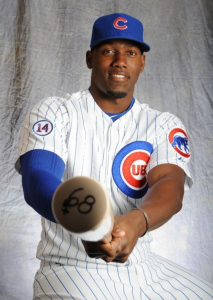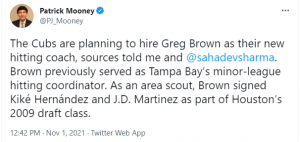MLB Trade Rumors is proud to present our 12th annual Top 50 Free Agents list!
1. Yu Darvish – Cubs. Six years, $160MM. Let’s start by addressing the elephant in the room. Darvish recorded a mere ten outs in his two brutal World Series starts for the Dodgers. With those ugly outings fresh in our minds, projecting him to receive the winter’s largest contract creates cognitive dissonance. However, Darvish remains what he was a week ago: a very good starting pitcher and the best in this free agent class.
Darvish spent the first seven years of his career in Japan starring for the Nippon Ham Fighters. The Fighters made Darvish available to MLB teams in December 2011, at a time when there was no limit on bidding for the exclusive right to negotiate with the player. The Rangers beat out the Blue Jays, Yankees, and Cubs with a $51.7MM bid and signed Darvish to a six-year, $56MM deal on top of that. Darvish’s fine Rangers career included 782 2/3 innings of 3.42 ERA ball with a 11.0 K/9, plus four All-Star appearances and a second-place Cy Young finish. He was traded to the Dodgers in July, making him ineligible for a $17.4MM qualifying offer. While with the Rangers, Darvish went about 22 months between starts due to Tommy John surgery. He’s been injury-free this year and nudged his way past the 200-inning plateau in his brief start last night. The 31-year-old righty should have no problem setting a new free agent record for a Tommy John survivor, passing Jordan Zimmermann’s five-year, $110MM deal. Seven-year contracts have historically been reserved for slightly younger pitchers without elbow surgery on their resume, so we’re expecting six years for Darvish. Free agent starters have exceeded a $25MM salary four different times, and we’re projecting Darvish to become the fifth. If the Dodgers decide to move on, the Cubs, Phillies, Nationals, Cardinals, Astros, and Twins could be potential suitors. There’s a shortage of obvious big-market players here, allowing for dark horses to enter the mix.
2. J.D. Martinez – Red Sox. Six years, $150MM. Martinez came up through the Astros’ farm system but struggled through 975 plate appearances in the Majors and was released in March 2014. The Astros didn’t understand the impact of his recently-overhauled swing. The Tigers scooped Martinez up on a minor league deal, and he went on to rake at a .300/.361/.551 pace with 99 home runs in 1,886 plate appearances for them from 2014-17. A trade to the Diamondbacks this past July removed the possibility of a qualifying offer and boosted Martinez’s stock further as he went nuts with 29 home runs in 62 games. He finished with a career-high 45 bombs on the season. The biggest knock on Martinez is his right field defense, which has been a clear negative for the last two years. He also missed significant time with an elbow fracture in 2016 and a foot sprain to begin this year. Still, Martinez’s right-handed power will make him the most coveted bat on the market, enough that teams without corner outfield openings could trade someone to create a spot. The Diamondbacks may not have the payroll space to retain Martinez, leaving the Cardinals, Red Sox, and Giants as top suitors.
3. Eric Hosmer – Royals. Six years, $132MM. Every year one free agent is particularly polarizing, and this winter it’s Hosmer. The first baseman did solid work for the Royals over seven seasons, with a well-timed career-best batting line of .318/.385/.498 in 671 plate appearances this year. He just turned 28 and will be looking for at least six years — quite likely more. However, defensive metrics rate his glove poorly (a 2017 Gold Glove nomination notwithstanding), and off years with the bat resulted in replacement level seasons in 2014 and ’16. A case will be made for a $200MM contract, but it’s not a very good case. Teams seeking a first baseman have free-agent alternatives such as Carlos Santana, Logan Morrison, and Yonder Alonso, as well as trade candidate Jose Abreu. If Hosmer gets a huge contract, it probably won’t be from the game’s more analytical teams. The Royals seem likely to make a spirited effort to retain Hosmer as the face of their franchise, while the Red Sox, Cardinals, Mariners, and Rockies could enter the market to varying degrees. Hosmer is a lock to receive and reject a qualifying offer.
4. Jake Arrieta – Brewers. Four years, $100MM. A July 2013 trade from the Orioles to the Cubs rebooted Arrieta’s career, which peaked with the NL Cy Young Award in 2015. Arrieta’s star has dimmed since then, as he’s become more prone to walks, home runs, and hits and stopped pitching deep into games. He still provided value to the 2017 Cubs, with 30 starts of 3.53 ERA ball. Though he turns 32 in March, Arrieta’s case for a long-term deal is boosted by excellent physical conditioning. We expect him to come out looking for a six-year deal, but land at four or five. Arrieta appears likely to move on from the Cubs, with whom he was unable to agree to an extension in the past few years. However, it’s possible Arrieta could circle back to the Cubs later in the offseason if his market disappoints. We don’t see a clear favorite to sign him, so we’ve chosen a dark horse pick in the Brewers. The Cardinals, Nationals, Astros, Rangers, Phillies, Yankees, Angels, Mariners, Braves, Twins, and Dodgers could be in the mix depending on the price.
5. Masahiro Tanaka – Phillies. Five years, $100MM. Tanaka, 29 this month, is coming off his fourth and perhaps worst MLB season. He posted a 4.74 ERA in 30 regular season starts, with a ridiculous 21.2% of his flyballs allowed becoming home runs. It wasn’t a Yankee Stadium problem, as Tanaka was even more homer-prone on the road. On the bright side, Tanaka put up a career-best strikeout rate, a 3.77 ERA in the second half, and three excellent, homer-free postseason starts. Back in January 2014, Tanaka joined the Yankees via the Japanese baseball posting system after pitching seven years for the Rakuten Golden Eagles. With the posting fee capped at $20MM, the Yankees won the bidding over the Cubs, White Sox, Dodgers, and Diamondbacks with a seven-year, $155MM deal that included an opt-out that comes due at midnight on Saturday. The biggest wrinkle in Tanaka’s long-term prospects may be the partially torn UCL in his right elbow, which surfaced more than three years ago. Tanaka went the rehab route instead of undergoing Tommy John surgery. In 2015 Tanaka missed time with a forearm strain and had arthroscopic elbow surgery in the offseason. This year, he had a DL stint for shoulder fatigue. If Tanaka opts out, he will be walking away from three years and $67MM left on his Yankees contract. Ervin Santana was able to land a four-year deal with a rehabbed and healed UCL, and it seems that opting out is the right call for Tanaka. The Yankees could be in a position to lower their luxury tax hit by adding a year or two and reducing the average annual value of his contract. If Tanaka moves on from the Yankees, the Cubs, Nationals, Astros, Cardinals, Dodgers, Angels, Phillies, Twins, Mariners, Rangers, and Brewers could be possibilities. If he does opt out, the Yankees will assuredly issue a qualifying offer in order to collect draft-pick compensation.
6. Mike Moustakas – Braves. Five years, $85MM. Moustakas, 29, set a Royals franchise record with 38 home runs this year. The second overall draft pick in 2007, Moustakas didn’t click as a hitter until 2015. The third baseman suffered an ACL tear in May 2016, ending that season early, but exhibited no health problems in his return this year. The biggest flaw in Moose’s game is his low 5.7% walk rate this year, resulting in a .314 OBP that drove down his overall value as a hitter despite the power. Defensive metrics were also down on his once well-regarded glovework this year, though teams may be willing to chalk that up to rust coming off his knee injury. Regardless, he should do well in free agency. If the Royals move on, the Angels, Braves, and Cardinals could be options. Like Hosmer, Moustakas is going to receive and reject a qualifying offer.
7. Lorenzo Cain – Giants. Four years, $70MM. Yet another Royals free agent, Cain adds value with his hitting, baserunning, and glove as a center fielder. He’s a speedy, well-rounded player who was worth more than four wins above replacement this year. Dexter Fowler’s five-year, $82.5MM deal with the Cardinals will be a likely model, though Cain is a year older than Fowler was. Cain is the only plus defensive center fielder on the market who also carries an above-average bat, which should create plenty of demand. If the Royals don’t retain him, the Giants, Mariners, Blue Jays, and Rangers could be matches. The Royals have reportedly yet to decide on a qualifying offer for Cain, but it’d be a big surprise if he doesn’t get one.
8. Wade Davis – Astros. Four years, $60MM. Davis, 32, came up as a starter in the Rays system and was traded with James Shields to the Royals in a December 2012 blockbuster. 2013 was a tumultuous year for Davis – his wife had a baby, he lost his stepbrother unexpectedly, and he pitched his way out of the rotation by August. He began 2014 as the Royals’ setup man and never looked back, garnering Cy Young votes in a dominant season. He moved into the team’s closer role when Greg Holland got hurt the following year and will forever be remembered flinging his glove into the air after punching out Wilmer Flores looking to end the 2015 World Series. Davis missed time late in 2016 with a flexor strain in his pitching elbow, but the Cubs were not deterred in deftly trading Jorge Soler for him last offseason. Davis had a fine year as the Cubs’ closer, though he walked more than five batters per nine innings in the second half and that trend continued as manager Joe Maddon pushed him into multi-inning postseason stints. Despite a few warts, Davis is the best closer available and will likely be targeting Mark Melancon’s four-year, $62MM deal from last winter. The Cubs shied away from big-money closers last winter, but it’s still possible they could pony up for Davis. If the Cubs look elsewhere, the Astros, Cardinals, Rangers, Nationals, Twins, Braves, and Rockies could be fits. Davis is another slam-dunk recipient of the qualifying offer and will reject in search of a long-term deal.
9. Lance Lynn – Rangers. Four years, $56MM. Lynn, a 30-year-old righty, kicks off the second tier of free-agent starting pitching. He made 161 starts for the Cardinals in his career, regularly topping 30 per year. Lynn went under the knife for Tommy John surgery in November 2015. He missed all of 2016, as expected, but was one of only 12 pitchers to reach 33 regular season starts in 2017. While Lynn was never a big control guy, his 3.8 walks per nine innings was the second-worst mark of all qualified MLB starters. His strikeout and home run rates were also career worsts, so his 3.43 ERA can be attributed largely to a .241 batting average on balls in play. If Lynn’s BABIP regresses and other rates hold steady, his ERA could easily jump past the mid-4.00s. Still, Lynn takes the ball every fifth day and has had a lot of big league success since 2012. The righty’s reported asking price of $100MM+ over five years seems unattainable, but half of baseball is seeking rotation help. That includes the Rangers, Orioles, Twins, Mariners, Phillies, Cubs, and Brewers. Given the expected demand for Lynn, the Cardinals are likely to make a qualifying offer, and he’s likely to reject.
10. Greg Holland – Cardinals. Four years, $50MM. Holland ascended to the Royals’ closer job when they traded Jonathan Broxton at the 2012 trade deadline. He established his dominance in 2013-14 with a 1.32 ERA and 13.4 K/9 in 129 1/3 regular season innings, earning Cy Young Votes and All-Star nods in each season. Holland apparently tore his elbow ligament late in the 2014 season, pitching through the injury in 2015 before succumbing to Tommy John surgery shortly before his team began its World Series run. He spent 2016 as a rehabbing free agent and landed a one-year contract with the Rockies in January of this year. A $15MM player option for 2018 vested in that contract, which he will reportedly decline in search of a multiyear deal. Holland was healthy in 2017 and was one of the best relievers in baseball for the first two months of the season. He endured a brutal eight-game stretch in August before rebounding with a strong finish in his final 11 regular-season appearances. Holland will have a market similar to that of his former setup man, Wade Davis. Considering the fact that he’s turning down a $15MM player option, Holland is a lock to also reject a one-year, $17.4MM qualifying offer.
11. Alex Cobb – Twins. Four years, $48MM. Cobb, 30, came up through the Rays system and posted a stellar 3.21 ERA over his first 81 starts across four seasons. The righty went down for Tommy John surgery in May 2015, returning to the Majors in September of the following year without much success. The Cobb we saw in 2017 wasn’t quite at pre-surgery form, but he did stay healthy and posted a 3.66 ERA in a career-high 179 1/3 innings. Cobb had a 3.07 ERA over his final 17 starts and exhibited the best control of his career. He hasn’t been able to match his pre-surgery strikeout rate, so as with Lynn, there is concern that his ERA isn’t sustainable with the present skills. Cobb should pair with Lynn to form the second tier of starting pitching, and their markets will likely have plenty of overlap. A qualifying offer is a risk for the payroll-conscious Rays, but they’re reportedly leaning that way with Cobb, which seems like the right call to make.
12. Carlos Santana – Indians. Three years, $45MM. Santana is the best first base option after Hosmer. 32 in April, the switch-hitter came up as a catcher in the Dodgers’ system and was traded to the Indians in the July 2008 Casey Blake deal. By 2014, he was mainly a first baseman and designated hitter in Cleveland. Santana draws tons of walks, hits for power and gets quality reviews for his glovework at first base. He makes for a much more affordable Plan B to Hosmer and has a chance at landing four years on the open market. If the Indians let him go, the Red Sox, Royals, Angels, Mariners, Cardinals, Astros, and Twins could be suitors.
13. Zack Cozart – Padres. Three years, $42MM. Cozart, 32, has served as the Reds’ starting shortstop since 2012. His defense has always graded above average at the position. Cozart started to show a little more with the bat in 2015-16 but broke out in a huge way with walks and power this year. The total package was worth five wins above replacement, tops among free agents. Cozart was one of the five best shortstops in the game this year, period, despite playing only 122 games due to multiple DL stints for quad strains. The most serious injury on Cozart’s resume came in June 2015, when he required season-ending knee surgery for a torn ligament. Though he avoided the DL until September the following year, Cozart’s knee and other injuries limited him to 121 games in 2016. He hasn’t played a full season since 2014. The Reds entertained trade scenarios for Cozart over the years, nearly dealing him to the Mariners at the 2016 deadline, but were unable to find a match. While Cozart’s play would justify a four-year deal, only a handful of teams like the Royals, Marlins, Cardinals, and Padres might be seeking a shortstop. The Nationals could get creative and move Trea Turner to center field, or Cozart could expand his options by being open to playing second or third base. That could add teams like the Blue Jays, Angels, and Mets to the mix. The Reds are reportedly leaning against a $17.4MM qualifying offer for Cozart, though we’re of the general belief that it’s a risk worth taking.
14. Jay Bruce – Blue Jays. Three years, $39MM. Bruce reached the Majors at age 21 with the Reds and hit 216 home runs in nine seasons before he was traded to the Mets at last year’s deadline. While with the Reds in 2010, Bruce signed a six-year, $51MM extension that included a club option for ’17. The Mets exercised that club option last winter, and ended up trading Bruce to the Indians in August. The left-handed slugger has endured ups and downs as a hitter, but he posted a 115 wRC+ with 69 home runs over the last two seasons despite a .317 OBP. Bruce has struggled against left-handed pitching, a weakness that has been exploited by opposing managers who have forced him to face a disproportionate amount of southpaws. Bruce has not generally been lauded for his right field defense since undergoing knee surgery a few years ago, but his metrics bounced back and were above average this year. Bruce turns 31 in April and has a shot at a four-year deal in the Josh Reddick vicinity. The Blue Jays, Orioles, Royals, Rockies, Cardinals, and Giants could be options if the Indians let him leave.
15. Logan Morrison – Red Sox. Three years, $36MM. Morrison broke in with the Marlins in 2010 after ranking as a consensus Top 100 prospect and looked like an above average hitter early in his career. His bat went downhill, however, and the first baseman was traded to the Mariners in 2013, later joining the Rays as a free agent. This year for Tampa Bay, Morrison finally broke out with 38 home runs and a 13.5% walk rate. A left-handed batter, LoMo’s platoon issues have come and gone over the years, but he’s been fine against southpaws lately. Morrison is only 30 years old and should be a relatively cost-effective power bat with a market similar to that of Santana. His more limited track record and inferior (but still solid) defensive metrics caused us to rank him a bit lower, but a four-year deal isn’t out of the question.
16. Addison Reed – Cubs. Four years, $36MM. Reed has a chance to follow in the footsteps of Andrew Miller, Darren O’Day, and Brett Cecil to land a four-year deal as reliever who won’t necessarily serve as a closer. Reed did rack up saves for the White Sox and Diamondbacks from 2012-14, but stood out with the Mets as a dominant setup man in 2016. He began this season as the Mets’ stopper due to Jeurys Familia’s suspension. A blood clot put Familia on the DL in May, and Reed regained closing duties until a July trade to Boston, where he set up Craig Kimbrel. Over the last two years, Reed has a 2.40 ERA, 9.8 K/9, and 1.6 BB/9 in 153 2/3 innings, showing remarkable control for a reliever. He doesn’t turn 29 until December and will be a popular target for teams unwilling to meet the demands of Wade Davis and Greg Holland. The Cubs, Astros, Cardinals, Twins, Rangers, Braves, Rockies, and Dodgers are among the potential suitors.
17. Todd Frazier – Mets. Three years, $33MM. Frazier, 32 in February, is a quality option at the hot corner who won’t break the bank. He’s been an above-average but unremarkable hitter for the White Sox and Yankees over the last two years, hitting .220/.322/.448 with 67 home runs. Combined with mostly above-average defense at third base and a strong clubhouse reputation, Frazier is a quietly valuable player. He’s the cheaper alternative to Mike Moustakas and could fit with the Mets, Royals, Angels, Braves, Cardinals, or Yankees.
18. Mike Minor – Dodgers. Four years, $28MM. Minor came up through the Braves’ system and had several strong years as a starting pitcher. He started experiencing shoulder problems in 2014, eventually having surgery in May 2015. The Braves chose to non-tender him, leading to a two-year, $7.25MM deal with the Royals in February 2016. Minor’s shoulder would not cooperate, and the lefty was not able to make it back to a big league mound in 2016, ultimately returning this year as a reliever. The Royals brought him along carefully and were rewarded with a dominant season in relief: a 2.55 ERA, 10.2 K/9, and 2.5 BB/9 in 77 2/3 innings. He should be a popular target as a late-inning reliever who can go more than one inning. The three-year deals given to Mike Dunn and Tony Sipp could serve as a baseline, while enough competition could force something closer to Brett Cecil’s four-year deal. Minor could also get escalators for starting, though he’d leave too much money on the table by requiring a return to his old role. Frankly, given the always-high level of demand for shutdown left-handed relievers, the number of teams interested in Minor should outweigh the number of teams that don’t have interest.
19. Brandon Morrow – Rockies. Three years, $24MM. Morrow followed an interesting path to becoming Kenley Jansen’s wingman for the Dodgers in the World Series. Drafted fifth overall by the Mariners in 2006, the hard-throwing righty and Type 1 diabetic skipped the minors and spent his Mariners career being almost comically jerked in and out of late inning relief and starting roles, battling injuries along the way. Then the Blue Jays traded for him and committed to a starting role, eventually buying out a free agent year and getting mixed results and a ton of time missed due to injuries from 2010-14. Morrow later landed with the Padres on a cheap free agent deal, making only five starts before a shoulder injury ended his season. Coming off shoulder surgery, he took a minor league deal to stay with the Padres in 2016. That was followed by a minor league deal with the Dodgers in January 2017, along with a full commitment to a relief role. Morrow didn’t get up with the Dodgers for good until late June. He wound up posting a 2.06 ERA, 10.3 K/9, and 1.9 BB/9 with no home runs allowed in 43 2/3 innings, with that excellence continuing into the postseason. The Dodgers rode him hard, using Morrow in all seven World Series games. As Andrew Stoeten wrote for Vice Sports, Morrow is easy to root for after all he’s been through. Though a three-year deal might not seem rational for a pitcher with Morrow’s injury history, it wasn’t for Ryan Madson either. We expect that to be the cost of doing business to acquire Morrow and his 98 mile per hour heater.
20. Jonathan Lucroy – Rockies. Two years, $24MM. Lucroy, a 31-year-old catcher, has fallen far from the talk of a $100MM free agent deal. He still has a shot at three years, but a terrible start to the season with the Rangers killed much of his value. Lucroy spent many years as one of the game’s best-hitting catchers and one of the best pitch framers. Unfortunately, he dropped from 24 home runs last year to just six this year, and his framing numbers plummeted as well. Lucroy’s bat did bounce back somewhat in 46 games with the Rockies after a trade. One big issue is that there aren’t many teams seeking a catcher this winter. The Rockies would like to retain Lucroy but may not face much competition. The Diamondbacks, Athletics, and White Sox are plausible fits on paper as well. Lucroy may be well-served with a deal similar to Matt Wieters, with a player option for the second year.
21. CC Sabathia – Yankees. Two years, $24MM. Sabathia is in the twilight of what could become a Hall of Fame career. Now 37, the big lefty has five top-five Cy Young finishes. He had a monster peak from 2006-12, winning the Cy Young award in ’07. The Yankees signed him to a record seven-year, $161MM deal in December 2008, later adding a year plus a vesting option to make it nine years in the Bronx. Sabathia posted a 3.81 ERA over 57 starts in the last two seasons, though his peripheral stats have moved in the wrong direction. He’d like to stay with the Yankees, which could mean settling for a one-year deal despite the possibility of two elsewhere. The Angels could be a good Plan B for Sabathia.
22. Yonder Alonso – Angels. Two years, $22MM. Alonso was drafted by the Reds in 2008, who traded him to the Padres as a major part of the 2011 Mat Latos trade. He was an underpowered first baseman for his entire Padres career, failing to reach 10 home runs in a season. A trade to Oakland didn’t change much initially, but this spring Alonso began a concerted effort to hit the ball hard in the air. He mashed for about two months, hitting .291/.391/.657 with 14 home runs in 156 plate appearances. Since June, though, Alonso hit .256/.353/.435 with 14 home runs in 365 plate appearances. Still a decent hitter, but not a star. Alonso struggles against left-handed pitching, and was kept in a strict platoon after an August trade to Seattle. Set to turn 31 in April, Alonso had a strong 2017 season overall but may be greeted with skepticism in a crowded first-base market. Still, he presents a potential bargain if he settles in as a 120 wRC+ guy, which is what Eric Hosmer has been over the last three years.
23. Carlos Gomez – Royals. Two years, $22MM. Gomez was a superstar for the 2013-14 Brewers. After that he battled injuries and tanked after a 2015 trade to Houston. He’s since become useful again, hitting .262/.345/.481 in his 556 plate appearances with the Rangers. Gomez is able to play an average center field as he approaches his 32nd birthday, but he continues to have trouble with injuries. He can still help a team like the Royals, Mariners, Orioles, Blue Jays, Indians, Athletics, or Giants.
24. Juan Nicasio – Twins. Three years, $21MM. Nicasio never had much success as a starter with the Rockies. After a stop with the Dodgers, the Pirates signed Nicasio as a free agent, and the righty earned a rotation spot with a dominant spring in 2016. He pitched his way back into the bullpen that summer and remained with the Pirates for ’17 as an arbitration eligible player. Nicasio did strong work through 65 games, but was then surprisingly put on outright waivers in August in a penny-pinching move by the Bucs. The Phillies grabbed him, dealing him to the Cardinals in a rare September trade a week later. Nicasio wound up serving as the Cardinals’ closer, despite ineligibility for the playoffs had the Cards made it. It was an odd series of transactions for Nicasio, who has discussed a contract with the Cardinals. The 31-year-old posted a 2.61 ERA, 9.0 K/9, and 2.5 BB/9 on the season overall and might be able to snag a three-year deal on the open market.
25. Bryan Shaw – Red Sox. Three years, $21MM. Shaw has been a mainstay in the Indians’ bullpen since joining them as a piece in the 2012 Shin-Soo Choo three-way trade. From 2013-17, no one has appeared in more MLB games than Shaw’s 442. He’s never been on the disabled list. Shaw doesn’t have amazing control or a dominant strikeout rate, but he’s never posted an ERA above this year’s 3.52. He’ll turn 30 in November and figures to seek a three-year deal.
1. Yu Darvish – Cubs. Six years, $160MM. Let’s start by addressing the elephant in the room. Darvish recorded a mere ten outs in his two brutal World Series starts for the Dodgers. With those ugly outings fresh in our minds, projecting him to receive the winter’s largest contract creates cognitive dissonance. However, Darvish remains what he was a week ago: a very good starting pitcher and the best in this free agent class.
Darvish spent the first seven years of his career in Japan starring for the Nippon Ham Fighters. The Fighters made Darvish available to MLB teams in December 2011, at a time when there was no limit on bidding for the exclusive right to negotiate with the player. The Rangers beat out the Blue Jays, Yankees, and Cubs with a $51.7MM bid and signed Darvish to a six-year, $56MM deal on top of that. Darvish’s fine Rangers career included 782 2/3 innings of 3.42 ERA ball with a 11.0 K/9, plus four All-Star appearances and a second-place Cy Young finish. He was traded to the Dodgers in July, making him ineligible for a $17.4MM qualifying offer. While with the Rangers, Darvish went about 22 months between starts due to Tommy John surgery. He’s been injury-free this year and nudged his way past the 200-inning plateau in his brief start last night. The 31-year-old righty should have no problem setting a new free agent record for a Tommy John survivor, passing Jordan Zimmermann’s five-year, $110MM deal. Seven-year contracts have historically been reserved for slightly younger pitchers without elbow surgery on their resume, so we’re expecting six years for Darvish. Free agent starters have exceeded a $25MM salary four different times, and we’re projecting Darvish to become the fifth. If the Dodgers decide to move on, the Cubs, Phillies, Nationals, Cardinals, Astros, and Twins could be potential suitors. There’s a shortage of obvious big-market players here, allowing for dark horses to enter the mix.
2. J.D. Martinez – Red Sox. Six years, $150MM. Martinez came up through the Astros’ farm system but struggled through 975 plate appearances in the Majors and was released in March 2014. The Astros didn’t understand the impact of his recently-overhauled swing. The Tigers scooped Martinez up on a minor league deal, and he went on to rake at a .300/.361/.551 pace with 99 home runs in 1,886 plate appearances for them from 2014-17. A trade to the Diamondbacks this past July removed the possibility of a qualifying offer and boosted Martinez’s stock further as he went nuts with 29 home runs in 62 games. He finished with a career-high 45 bombs on the season. The biggest knock on Martinez is his right field defense, which has been a clear negative for the last two years. He also missed significant time with an elbow fracture in 2016 and a foot sprain to begin this year. Still, Martinez’s right-handed power will make him the most coveted bat on the market, enough that teams without corner outfield openings could trade someone to create a spot. The Diamondbacks may not have the payroll space to retain Martinez, leaving the Cardinals, Red Sox, and Giants as top suitors.
3. Eric Hosmer – Royals. Six years, $132MM. Every year one free agent is particularly polarizing, and this winter it’s Hosmer. The first baseman did solid work for the Royals over seven seasons, with a well-timed career-best batting line of .318/.385/.498 in 671 plate appearances this year. He just turned 28 and will be looking for at least six years — quite likely more. However, defensive metrics rate his glove poorly (a 2017 Gold Glove nomination notwithstanding), and off years with the bat resulted in replacement level seasons in 2014 and ’16. A case will be made for a $200MM contract, but it’s not a very good case. Teams seeking a first baseman have free-agent alternatives such as Carlos Santana, Logan Morrison, and Yonder Alonso, as well as trade candidate Jose Abreu. If Hosmer gets a huge contract, it probably won’t be from the game’s more analytical teams. The Royals seem likely to make a spirited effort to retain Hosmer as the face of their franchise, while the Red Sox, Cardinals, Mariners, and Rockies could enter the market to varying degrees. Hosmer is a lock to receive and reject a qualifying offer.
4. Jake Arrieta – Brewers. Four years, $100MM. A July 2013 trade from the Orioles to the Cubs rebooted Arrieta’s career, which peaked with the NL Cy Young Award in 2015. Arrieta’s star has dimmed since then, as he’s become more prone to walks, home runs, and hits and stopped pitching deep into games. He still provided value to the 2017 Cubs, with 30 starts of 3.53 ERA ball. Though he turns 32 in March, Arrieta’s case for a long-term deal is boosted by excellent physical conditioning. We expect him to come out looking for a six-year deal, but land at four or five. Arrieta appears likely to move on from the Cubs, with whom he was unable to agree to an extension in the past few years. However, it’s possible Arrieta could circle back to the Cubs later in the offseason if his market disappoints. We don’t see a clear favorite to sign him, so we’ve chosen a dark horse pick in the Brewers. The Cardinals, Nationals, Astros, Rangers, Phillies, Yankees, Angels, Mariners, Braves, Twins, and Dodgers could be in the mix depending on the price.
5. Masahiro Tanaka – Phillies. Five years, $100MM. Tanaka, 29 this month, is coming off his fourth and perhaps worst MLB season. He posted a 4.74 ERA in 30 regular season starts, with a ridiculous 21.2% of his flyballs allowed becoming home runs. It wasn’t a Yankee Stadium problem, as Tanaka was even more homer-prone on the road. On the bright side, Tanaka put up a career-best strikeout rate, a 3.77 ERA in the second half, and three excellent, homer-free postseason starts. Back in January 2014, Tanaka joined the Yankees via the Japanese baseball posting system after pitching seven years for the Rakuten Golden Eagles. With the posting fee capped at $20MM, the Yankees won the bidding over the Cubs, White Sox, Dodgers, and Diamondbacks with a seven-year, $155MM deal that included an opt-out that comes due at midnight on Saturday. The biggest wrinkle in Tanaka’s long-term prospects may be the partially torn UCL in his right elbow, which surfaced more than three years ago. Tanaka went the rehab route instead of undergoing Tommy John surgery. In 2015 Tanaka missed time with a forearm strain and had arthroscopic elbow surgery in the offseason. This year, he had a DL stint for shoulder fatigue. If Tanaka opts out, he will be walking away from three years and $67MM left on his Yankees contract. Ervin Santana was able to land a four-year deal with a rehabbed and healed UCL, and it seems that opting out is the right call for Tanaka. The Yankees could be in a position to lower their luxury tax hit by adding a year or two and reducing the average annual value of his contract. If Tanaka moves on from the Yankees, the Cubs, Nationals, Astros, Cardinals, Dodgers, Angels, Phillies, Twins, Mariners, Rangers, and Brewers could be possibilities. If he does opt out, the Yankees will assuredly issue a qualifying offer in order to collect draft-pick compensation.
6. Mike Moustakas – Braves. Five years, $85MM. Moustakas, 29, set a Royals franchise record with 38 home runs this year. The second overall draft pick in 2007, Moustakas didn’t click as a hitter until 2015. The third baseman suffered an ACL tear in May 2016, ending that season early, but exhibited no health problems in his return this year. The biggest flaw in Moose’s game is his low 5.7% walk rate this year, resulting in a .314 OBP that drove down his overall value as a hitter despite the power. Defensive metrics were also down on his once well-regarded glovework this year, though teams may be willing to chalk that up to rust coming off his knee injury. Regardless, he should do well in free agency. If the Royals move on, the Angels, Braves, and Cardinals could be options. Like Hosmer, Moustakas is going to receive and reject a qualifying offer.
7. Lorenzo Cain – Giants. Four years, $70MM. Yet another Royals free agent, Cain adds value with his hitting, baserunning, and glove as a center fielder. He’s a speedy, well-rounded player who was worth more than four wins above replacement this year. Dexter Fowler’s five-year, $82.5MM deal with the Cardinals will be a likely model, though Cain is a year older than Fowler was. Cain is the only plus defensive center fielder on the market who also carries an above-average bat, which should create plenty of demand. If the Royals don’t retain him, the Giants, Mariners, Blue Jays, and Rangers could be matches. The Royals have reportedly yet to decide on a qualifying offer for Cain, but it’d be a big surprise if he doesn’t get one.
8. Wade Davis – Astros. Four years, $60MM. Davis, 32, came up as a starter in the Rays system and was traded with James Shields to the Royals in a December 2012 blockbuster. 2013 was a tumultuous year for Davis – his wife had a baby, he lost his stepbrother unexpectedly, and he pitched his way out of the rotation by August. He began 2014 as the Royals’ setup man and never looked back, garnering Cy Young votes in a dominant season. He moved into the team’s closer role when Greg Holland got hurt the following year and will forever be remembered flinging his glove into the air after punching out Wilmer Flores looking to end the 2015 World Series. Davis missed time late in 2016 with a flexor strain in his pitching elbow, but the Cubs were not deterred in deftly trading Jorge Soler for him last offseason. Davis had a fine year as the Cubs’ closer, though he walked more than five batters per nine innings in the second half and that trend continued as manager Joe Maddon pushed him into multi-inning postseason stints. Despite a few warts, Davis is the best closer available and will likely be targeting Mark Melancon’s four-year, $62MM deal from last winter. The Cubs shied away from big-money closers last winter, but it’s still possible they could pony up for Davis. If the Cubs look elsewhere, the Astros, Cardinals, Rangers, Nationals, Twins, Braves, and Rockies could be fits. Davis is another slam-dunk recipient of the qualifying offer and will reject in search of a long-term deal.
9. Lance Lynn – Rangers. Four years, $56MM. Lynn, a 30-year-old righty, kicks off the second tier of free-agent starting pitching. He made 161 starts for the Cardinals in his career, regularly topping 30 per year. Lynn went under the knife for Tommy John surgery in November 2015. He missed all of 2016, as expected, but was one of only 12 pitchers to reach 33 regular season starts in 2017. While Lynn was never a big control guy, his 3.8 walks per nine innings was the second-worst mark of all qualified MLB starters. His strikeout and home run rates were also career worsts, so his 3.43 ERA can be attributed largely to a .241 batting average on balls in play. If Lynn’s BABIP regresses and other rates hold steady, his ERA could easily jump past the mid-4.00s. Still, Lynn takes the ball every fifth day and has had a lot of big league success since 2012. The righty’s reported asking price of $100MM+ over five years seems unattainable, but half of baseball is seeking rotation help. That includes the Rangers, Orioles, Twins, Mariners, Phillies, Cubs, and Brewers. Given the expected demand for Lynn, the Cardinals are likely to make a qualifying offer, and he’s likely to reject.
10. Greg Holland – Cardinals. Four years, $50MM. Holland ascended to the Royals’ closer job when they traded Jonathan Broxton at the 2012 trade deadline. He established his dominance in 2013-14 with a 1.32 ERA and 13.4 K/9 in 129 1/3 regular season innings, earning Cy Young Votes and All-Star nods in each season. Holland apparently tore his elbow ligament late in the 2014 season, pitching through the injury in 2015 before succumbing to Tommy John surgery shortly before his team began its World Series run. He spent 2016 as a rehabbing free agent and landed a one-year contract with the Rockies in January of this year. A $15MM player option for 2018 vested in that contract, which he will reportedly decline in search of a multiyear deal. Holland was healthy in 2017 and was one of the best relievers in baseball for the first two months of the season. He endured a brutal eight-game stretch in August before rebounding with a strong finish in his final 11 regular-season appearances. Holland will have a market similar to that of his former setup man, Wade Davis. Considering the fact that he’s turning down a $15MM player option, Holland is a lock to also reject a one-year, $17.4MM qualifying offer.
11. Alex Cobb – Twins. Four years, $48MM. Cobb, 30, came up through the Rays system and posted a stellar 3.21 ERA over his first 81 starts across four seasons. The righty went down for Tommy John surgery in May 2015, returning to the Majors in September of the following year without much success. The Cobb we saw in 2017 wasn’t quite at pre-surgery form, but he did stay healthy and posted a 3.66 ERA in a career-high 179 1/3 innings. Cobb had a 3.07 ERA over his final 17 starts and exhibited the best control of his career. He hasn’t been able to match his pre-surgery strikeout rate, so as with Lynn, there is concern that his ERA isn’t sustainable with the present skills. Cobb should pair with Lynn to form the second tier of starting pitching, and their markets will likely have plenty of overlap. A qualifying offer is a risk for the payroll-conscious Rays, but they’re reportedly leaning that way with Cobb, which seems like the right call to make.
12. Carlos Santana – Indians. Three years, $45MM. Santana is the best first base option after Hosmer. 32 in April, the switch-hitter came up as a catcher in the Dodgers’ system and was traded to the Indians in the July 2008 Casey Blake deal. By 2014, he was mainly a first baseman and designated hitter in Cleveland. Santana draws tons of walks, hits for power and gets quality reviews for his glovework at first base. He makes for a much more affordable Plan B to Hosmer and has a chance at landing four years on the open market. If the Indians let him go, the Red Sox, Royals, Angels, Mariners, Cardinals, Astros, and Twins could be suitors.
13. Zack Cozart – Padres. Three years, $42MM. Cozart, 32, has served as the Reds’ starting shortstop since 2012. His defense has always graded above average at the position. Cozart started to show a little more with the bat in 2015-16 but broke out in a huge way with walks and power this year. The total package was worth five wins above replacement, tops among free agents. Cozart was one of the five best shortstops in the game this year, period, despite playing only 122 games due to multiple DL stints for quad strains. The most serious injury on Cozart’s resume came in June 2015, when he required season-ending knee surgery for a torn ligament. Though he avoided the DL until September the following year, Cozart’s knee and other injuries limited him to 121 games in 2016. He hasn’t played a full season since 2014. The Reds entertained trade scenarios for Cozart over the years, nearly dealing him to the Mariners at the 2016 deadline, but were unable to find a match. While Cozart’s play would justify a four-year deal, only a handful of teams like the Royals, Marlins, Cardinals, and Padres might be seeking a shortstop. The Nationals could get creative and move Trea Turner to center field, or Cozart could expand his options by being open to playing second or third base. That could add teams like the Blue Jays, Angels, and Mets to the mix. The Reds are reportedly leaning against a $17.4MM qualifying offer for Cozart, though we’re of the general belief that it’s a risk worth taking.
14. Jay Bruce – Blue Jays. Three years, $39MM. Bruce reached the Majors at age 21 with the Reds and hit 216 home runs in nine seasons before he was traded to the Mets at last year’s deadline. While with the Reds in 2010, Bruce signed a six-year, $51MM extension that included a club option for ’17. The Mets exercised that club option last winter, and ended up trading Bruce to the Indians in August. The left-handed slugger has endured ups and downs as a hitter, but he posted a 115 wRC+ with 69 home runs over the last two seasons despite a .317 OBP. Bruce has struggled against left-handed pitching, a weakness that has been exploited by opposing managers who have forced him to face a disproportionate amount of southpaws. Bruce has not generally been lauded for his right field defense since undergoing knee surgery a few years ago, but his metrics bounced back and were above average this year. Bruce turns 31 in April and has a shot at a four-year deal in the Josh Reddick vicinity. The Blue Jays, Orioles, Royals, Rockies, Cardinals, and Giants could be options if the Indians let him leave.
15. Logan Morrison – Red Sox. Three years, $36MM. Morrison broke in with the Marlins in 2010 after ranking as a consensus Top 100 prospect and looked like an above average hitter early in his career. His bat went downhill, however, and the first baseman was traded to the Mariners in 2013, later joining the Rays as a free agent. This year for Tampa Bay, Morrison finally broke out with 38 home runs and a 13.5% walk rate. A left-handed batter, LoMo’s platoon issues have come and gone over the years, but he’s been fine against southpaws lately. Morrison is only 30 years old and should be a relatively cost-effective power bat with a market similar to that of Santana. His more limited track record and inferior (but still solid) defensive metrics caused us to rank him a bit lower, but a four-year deal isn’t out of the question.
16. Addison Reed – Cubs. Four years, $36MM. Reed has a chance to follow in the footsteps of Andrew Miller, Darren O’Day, and Brett Cecil to land a four-year deal as reliever who won’t necessarily serve as a closer. Reed did rack up saves for the White Sox and Diamondbacks from 2012-14, but stood out with the Mets as a dominant setup man in 2016. He began this season as the Mets’ stopper due to Jeurys Familia’s suspension. A blood clot put Familia on the DL in May, and Reed regained closing duties until a July trade to Boston, where he set up Craig Kimbrel. Over the last two years, Reed has a 2.40 ERA, 9.8 K/9, and 1.6 BB/9 in 153 2/3 innings, showing remarkable control for a reliever. He doesn’t turn 29 until December and will be a popular target for teams unwilling to meet the demands of Wade Davis and Greg Holland. The Cubs, Astros, Cardinals, Twins, Rangers, Braves, Rockies, and Dodgers are among the potential suitors.
17. Todd Frazier – Mets. Three years, $33MM. Frazier, 32 in February, is a quality option at the hot corner who won’t break the bank. He’s been an above-average but unremarkable hitter for the White Sox and Yankees over the last two years, hitting .220/.322/.448 with 67 home runs. Combined with mostly above-average defense at third base and a strong clubhouse reputation, Frazier is a quietly valuable player. He’s the cheaper alternative to Mike Moustakas and could fit with the Mets, Royals, Angels, Braves, Cardinals, or Yankees.
18. Mike Minor – Dodgers. Four years, $28MM. Minor came up through the Braves’ system and had several strong years as a starting pitcher. He started experiencing shoulder problems in 2014, eventually having surgery in May 2015. The Braves chose to non-tender him, leading to a two-year, $7.25MM deal with the Royals in February 2016. Minor’s shoulder would not cooperate, and the lefty was not able to make it back to a big league mound in 2016, ultimately returning this year as a reliever. The Royals brought him along carefully and were rewarded with a dominant season in relief: a 2.55 ERA, 10.2 K/9, and 2.5 BB/9 in 77 2/3 innings. He should be a popular target as a late-inning reliever who can go more than one inning. The three-year deals given to Mike Dunn and Tony Sipp could serve as a baseline, while enough competition could force something closer to Brett Cecil’s four-year deal. Minor could also get escalators for starting, though he’d leave too much money on the table by requiring a return to his old role. Frankly, given the always-high level of demand for shutdown left-handed relievers, the number of teams interested in Minor should outweigh the number of teams that don’t have interest.
19. Brandon Morrow – Rockies. Three years, $24MM. Morrow followed an interesting path to becoming Kenley Jansen’s wingman for the Dodgers in the World Series. Drafted fifth overall by the Mariners in 2006, the hard-throwing righty and Type 1 diabetic skipped the minors and spent his Mariners career being almost comically jerked in and out of late inning relief and starting roles, battling injuries along the way. Then the Blue Jays traded for him and committed to a starting role, eventually buying out a free agent year and getting mixed results and a ton of time missed due to injuries from 2010-14. Morrow later landed with the Padres on a cheap free agent deal, making only five starts before a shoulder injury ended his season. Coming off shoulder surgery, he took a minor league deal to stay with the Padres in 2016. That was followed by a minor league deal with the Dodgers in January 2017, along with a full commitment to a relief role. Morrow didn’t get up with the Dodgers for good until late June. He wound up posting a 2.06 ERA, 10.3 K/9, and 1.9 BB/9 with no home runs allowed in 43 2/3 innings, with that excellence continuing into the postseason. The Dodgers rode him hard, using Morrow in all seven World Series games. As Andrew Stoeten wrote for Vice Sports, Morrow is easy to root for after all he’s been through. Though a three-year deal might not seem rational for a pitcher with Morrow’s injury history, it wasn’t for Ryan Madson either. We expect that to be the cost of doing business to acquire Morrow and his 98 mile per hour heater.
20. Jonathan Lucroy – Rockies. Two years, $24MM. Lucroy, a 31-year-old catcher, has fallen far from the talk of a $100MM free agent deal. He still has a shot at three years, but a terrible start to the season with the Rangers killed much of his value. Lucroy spent many years as one of the game’s best-hitting catchers and one of the best pitch framers. Unfortunately, he dropped from 24 home runs last year to just six this year, and his framing numbers plummeted as well. Lucroy’s bat did bounce back somewhat in 46 games with the Rockies after a trade. One big issue is that there aren’t many teams seeking a catcher this winter. The Rockies would like to retain Lucroy but may not face much competition. The Diamondbacks, Athletics, and White Sox are plausible fits on paper as well. Lucroy may be well-served with a deal similar to Matt Wieters, with a player option for the second year.
21. CC Sabathia – Yankees. Two years, $24MM. Sabathia is in the twilight of what could become a Hall of Fame career. Now 37, the big lefty has five top-five Cy Young finishes. He had a monster peak from 2006-12, winning the Cy Young award in ’07. The Yankees signed him to a record seven-year, $161MM deal in December 2008, later adding a year plus a vesting option to make it nine years in the Bronx. Sabathia posted a 3.81 ERA over 57 starts in the last two seasons, though his peripheral stats have moved in the wrong direction. He’d like to stay with the Yankees, which could mean settling for a one-year deal despite the possibility of two elsewhere. The Angels could be a good Plan B for Sabathia.
22. Yonder Alonso – Angels. Two years, $22MM. Alonso was drafted by the Reds in 2008, who traded him to the Padres as a major part of the 2011 Mat Latos trade. He was an underpowered first baseman for his entire Padres career, failing to reach 10 home runs in a season. A trade to Oakland didn’t change much initially, but this spring Alonso began a concerted effort to hit the ball hard in the air. He mashed for about two months, hitting .291/.391/.657 with 14 home runs in 156 plate appearances. Since June, though, Alonso hit .256/.353/.435 with 14 home runs in 365 plate appearances. Still a decent hitter, but not a star. Alonso struggles against left-handed pitching, and was kept in a strict platoon after an August trade to Seattle. Set to turn 31 in April, Alonso had a strong 2017 season overall but may be greeted with skepticism in a crowded first-base market. Still, he presents a potential bargain if he settles in as a 120 wRC+ guy, which is what Eric Hosmer has been over the last three years.
23. Carlos Gomez – Royals. Two years, $22MM. Gomez was a superstar for the 2013-14 Brewers. After that he battled injuries and tanked after a 2015 trade to Houston. He’s since become useful again, hitting .262/.345/.481 in his 556 plate appearances with the Rangers. Gomez is able to play an average center field as he approaches his 32nd birthday, but he continues to have trouble with injuries. He can still help a team like the Royals, Mariners, Orioles, Blue Jays, Indians, Athletics, or Giants.
24. Juan Nicasio – Twins. Three years, $21MM. Nicasio never had much success as a starter with the Rockies. After a stop with the Dodgers, the Pirates signed Nicasio as a free agent, and the righty earned a rotation spot with a dominant spring in 2016. He pitched his way back into the bullpen that summer and remained with the Pirates for ’17 as an arbitration eligible player. Nicasio did strong work through 65 games, but was then surprisingly put on outright waivers in August in a penny-pinching move by the Bucs. The Phillies grabbed him, dealing him to the Cardinals in a rare September trade a week later. Nicasio wound up serving as the Cardinals’ closer, despite ineligibility for the playoffs had the Cards made it. It was an odd series of transactions for Nicasio, who has discussed a contract with the Cardinals. The 31-year-old posted a 2.61 ERA, 9.0 K/9, and 2.5 BB/9 on the season overall and might be able to snag a three-year deal on the open market.
25. Bryan Shaw – Red Sox. Three years, $21MM. Shaw has been a mainstay in the Indians’ bullpen since joining them as a piece in the 2012 Shin-Soo Choo three-way trade. From 2013-17, no one has appeared in more MLB games than Shaw’s 442. He’s never been on the disabled list. Shaw doesn’t have amazing control or a dominant strikeout rate, but he’s never posted an ERA above this year’s 3.52. He’ll turn 30 in November and figures to seek a three-year deal.



